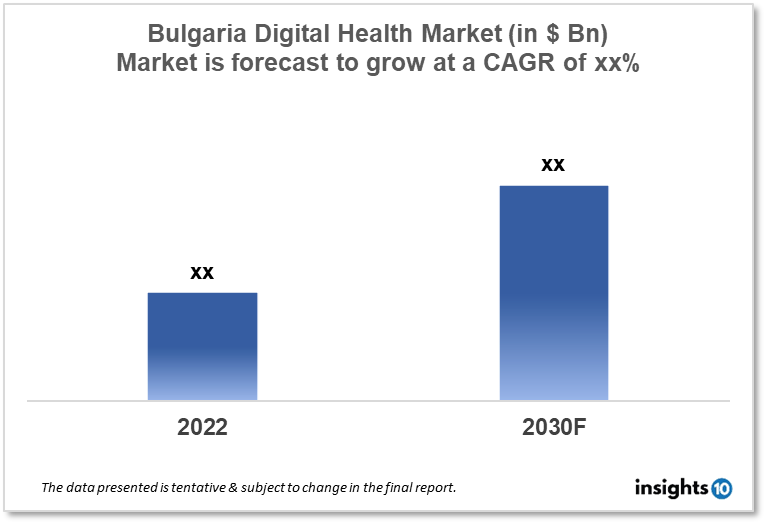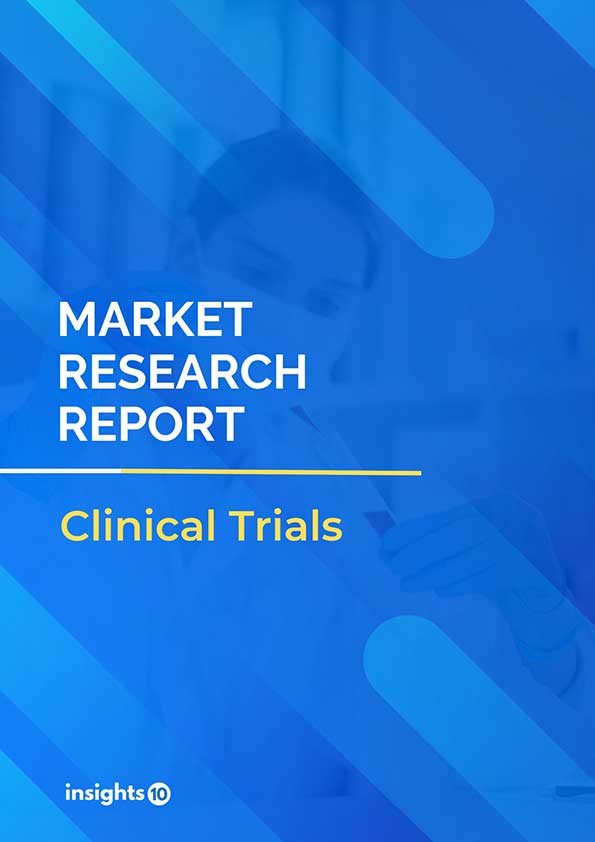Bulgaria Digital Health Market Analysis
Bulgaria's Digital Health market is projected to grow from $xxBn in 2022 to $xxBn by 2030, registering a CAGR xx% during the forecast period of 2022-30. The market will be driven by the efforts of the government to invest in digital health and Increasing demand for healthcare services. The market is segmented by solution, by deployment & by end-use. Some of the major players include Healee, CoLumbo & GymRealm.
Buy Now

Bulgaria Digital Health Market Executive Summary
Bulgaria's Digital Health market is projected to grow from $xxBn in 2022 to $xxBn by 2030, registering a CAGR xx% during the forecast period of 2022-30. Bulgaria's healthcare spending for 2019 was $698 (7.13% of GDP), a 1.16% rise from 2018 according to the World Health Organization Global Health Expenditure database. The government funds the bulk of the Bulgarian healthcare system through taxes, which account for the majority of healthcare expenditure. However, a minor portion of private healthcare expenditure is made up of out-of-pocket payments made by households for medical treatments not covered by the National Health Insurance Fund (NHIF).
In Bulgaria, various digital health enterprises are active, mostly providing telemedicine and e-health services. Furthermore, there is a rising tendency in Bulgaria for private health insurance coverage to cover expenditures not covered by the government health insurance fund, which is fuelling demand for digital health services.

Market Dynamics
Market Growth Drivers
Government assistance, such as the installation of electronic health records and telemedicine services, might create a more conducive climate in Bulgaria for the growth of digital health enterprises. Furthermore, the rising demand for healthcare services in Bulgaria, driven by factors such as an aging population and an increase in chronic illnesses, may result in an increased need for digital health solutions. Increasing healthcare expenses in Bulgaria are intended to lead more people to seek out other, more cost-effective options, such as digital health products and services.
Market Restraints
The Bulgarian digital health sector is being hampered by a number of factors that might hinder its expansion. The government has been hesitant to invest in digital health, limiting the industry from growth, as well as a lack of infrastructure to support digital health, such as a lack of high-speed internet in certain rural regions and a lack of digital literacy among healthcare workers. Bulgaria's legislative environment for digital health is still in its initial phases, making it challenging for digital health enterprises to operate in the nation.
Competitive Landscape
Key Players
- Healee (BGR): Patient and doctor teleconsultation app provider. Patients use the app to identify physicians, communicate symptoms, concerns, test results, and medical images, and request consultations
- CoLumbo (BGR): AI-powered radiography image analysis software for providers. The firm has created a medical imaging and management system
- GymRealm (BGR): GymRealm is a cloud-based application that assists users in locating fitness and sports facilities in order to better manage their activities
- FindMeCure (BGR): With a few clicks, anybody may readily locate future therapies and apply for participation in research
- Greenpie (BGR): Using the cloud services, connects professional nutritional software (for clinicians) with a nutrition fitness app (for patients)
Healthcare Policies and Regulatory Landscape
The Ministry of Health is in charge of developing healthcare policies and regulations in Bulgaria, including those pertaining to digital health, while the State Service of Bulgaria on Medicines and Drugs Control is in charge of medical device registration and control, including digital health products. The Bulgarian Personal Data Protection Act and Regulation will also apply to digital health software that processes personal data. The Bulgarian Constitution states that any tracking of an individual requires his or her approval. The Bulgarian Electronic Communications Act ("ECA") protects communication secrecy by forbidding any tapping, recording, storing, or other types of interception or monitoring of communications and related traffic data by people other than users without their authorization. Bulgarian Drug Agency exercises control over medical devices (which includes the software within a digital health app).
Reimbursement Scenario
The Bulgarian healthcare system is mostly funded by the National Health Insurance Fund (NHIF). However, it only covers a limited range of digital health services, and telemedicine is still not extensively covered. The reimbursement of digital health services in Bulgaria is still in its initial stages, and further progress is required before digital health reimbursement is completely integrated into the government's healthcare system.
1. Executive Summary
1.1 Digital Health Overview
1.2 Global Scenario
1.3 Country Overview
1.4 Healthcare Scenario in Country
1.5 Digital Health Policy in Country
1.6 Recent Developments in the Country
2. Market Size and Forecasting
2.1 Market Size (With Excel and Methodology)
2.2 Market Segmentation (Check all Segments in Segmentation Section)
3. Market Dynamics
3.1 Market Drivers
3.2 Market Restraints
4. Competitive Landscape
4.1 Major Market Share
4.2 Key Company Profile (Check all Companies in the Summary Section)
4.2.1 Company
4.2.1.1 Overview
4.2.1.2 Product Applications and Services
4.2.1.3 Recent Developments
4.2.1.4 Partnerships Ecosystem
4.2.1.5 Financials (Based on Availability)
5. Reimbursement Scenario
5.1 Reimbursement Regulation
5.2 Reimbursement Process for Diagnosis
5.3 Reimbursement Process for Treatment
6. Methodology and Scope
Digital Health Market Segmentation
The Digital Health Market is segmented as mentioned below:
By Solution (Revenue, USD Billion):
- Software
- Services
By Deployment (Revenue, USD Billion):
- Cloud-based
- On-premises
By End-use (Revenue, USD Billion):
- Diagnostic Centres
- Healthcare Payers
- Healthcare Research Centres
- Hospitals & Clinics
- Nursing Care Centres
- Others
Methodology for Database Creation
Our database offers a comprehensive list of healthcare centers, meticulously curated to provide detailed information on a wide range of specialties and services. It includes top-tier hospitals, clinics, and diagnostic facilities across 30 countries and 24 specialties, ensuring users can find the healthcare services they need.
Additionally, we provide a comprehensive list of Key Opinion Leaders (KOLs) based on your requirements. Our curated list captures various crucial aspects of the KOLs, offering more than just general information. Whether you're looking to boost brand awareness, drive engagement, or launch a new product, our extensive list of KOLs ensures you have the right experts by your side. Covering 30 countries and 36 specialties, our database guarantees access to the best KOLs in the healthcare industry, supporting strategic decisions and enhancing your initiatives.
How Do We Get It?
Our database is created and maintained through a combination of secondary and primary research methodologies.
1. Secondary Research
With many years of experience in the healthcare field, we have our own rich proprietary data from various past projects. This historical data serves as the foundation for our database. Our continuous process of gathering data involves:
- Analyzing historical proprietary data collected from multiple projects.
- Regularly updating our existing data sets with new findings and trends.
- Ensuring data consistency and accuracy through rigorous validation processes.
With extensive experience in the field, we have developed a proprietary GenAI-based technology that is uniquely tailored to our organization. This advanced technology enables us to scan a wide array of relevant information sources across the internet. Our data-gathering process includes:
- Searching through academic conferences, published research, citations, and social media platforms
- Collecting and compiling diverse data to build a comprehensive and detailed database
- Continuously updating our database with new information to ensure its relevance and accuracy
2. Primary Research
To complement and validate our secondary data, we engage in primary research through local tie-ups and partnerships. This process involves:
- Collaborating with local healthcare providers, hospitals, and clinics to gather real-time data.
- Conducting surveys, interviews, and field studies to collect fresh data directly from the source.
- Continuously refreshing our database to ensure that the information remains current and reliable.
- Validating secondary data through cross-referencing with primary data to ensure accuracy and relevance.
Combining Secondary and Primary Research
By integrating both secondary and primary research methodologies, we ensure that our database is comprehensive, accurate, and up-to-date. The combined process involves:
- Merging historical data from secondary research with real-time data from primary research.
- Conducting thorough data validation and cleansing to remove inconsistencies and errors.
- Organizing data into a structured format that is easily accessible and usable for various applications.
- Continuously monitoring and updating the database to reflect the latest developments and trends in the healthcare field.
Through this meticulous process, we create a final database tailored to each region and domain within the healthcare industry. This approach ensures that our clients receive reliable and relevant data, empowering them to make informed decisions and drive innovation in their respective fields.
To request a free sample copy of this report, please complete the form below.
We value your inquiry and offer free customization with every report to fulfil your exact research needs.










































